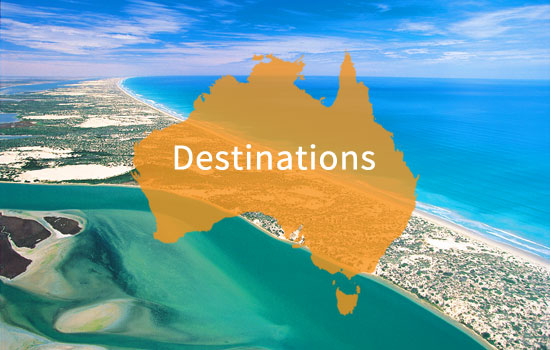Uluru & Kata Tjuta
Uluru, Uluru-Kata Tjuta National Park, NT. Photo credit: Tourism NT
Uluru & Kata Tjuta
If you think you know what to expect from Uluru, think again.
Organising your trip to Uluru
Uluru is a whopping 450km away from Alice Springs. If time is tight, fly into Ayers Rock Airport on any of the regular Qantas or Virgin Australia flights. It’s a 45 minute flight from Alice Springs, but you can fly here from most of the country’s major towns and cities.
There’s complimentary travel to Ayers Rock Resort (6km away) for every scheduled flight. You can also arrange car hire for your trip to Uluru at the airport.
If you’re thinking of driving to Uluru from Alice Springs in one day, set off early. It’s roughly a 4½ hr drive.
Also a formidable distance, but well worth it if time is on your side, is driving to Uluru via the stunning Red Centre Way. You can take Alice Springs, the MacDonnell Ranges and Watarrka National Park at your own pace, with accommodation and fuel stops on the way.
Should you visit/climb Uluru?
We’re not talking from a tourist perspective – Uluru is perhaps the Australian landmark and an essential visit. But it is also sacred to the Anangu people, the traditional owners of Uluru, Kata Tjuta and the surrounding area.
The Anangu are happy for people to visit, and keen to encourage understanding of their culture and history. They do, however, ask you to respect Tjukurpa, their law that connects them to the land, animals, and each other.
Then there’s the issue of climbing Uluru. Climbing upsets the Anangu as the route crosses a culturally significant Dreamtime track. Also, more than 30 people have died on the Uluru climb and the Anangu feel they have a responsibility to look after people on their land.
If you do plan to climb, visit the Uluru-Kata Tjuta Cultural Centre first to find out how to do so in a way that minimises your effect on the Anangu. Here you’ll gain an understanding of the significance of the sites to the Anangu people and learn about Tjukurpa. You can also learn about the history of the park and visit the craft shop to pick up a genuine hand-crafted souvenir.
Before you set off check the conditions. The climb can be extremely demanding, and will often be closed if the winds are too strong or the temperature is forecast to exceed 36°C.
Visiting Uluru
You’ll have seen hundreds of images of it– but nothing does it justice like the human eye. Seeing it at sunrise/sunset is an absolute must. Throughout the day, the rock appears to change colour, shifting between a red-brown monolith of crevices and shadow, to an almost mystical, glowing red at sunrise and sunset.
The walks and tours help you get beneath the skin of Uluru. We’d recommend the base walk, a 10km track that leads you around the bottom of the rock, taking you past paintings, caves and waterholes that build a picture of Uluru’s significance to the Anangu people. The walk takes 3-4 hours.
Staying safe
As with the rest of the Red Centre, it’s best to visit Uluru in winter. The heat can be intense in summer, with temperatures commonly reaching the mid-thirties °C.
If you have to visit Uluru during summer, try to plan your activities so that you’re finished by 11am and keep out of the midday sun. Use plenty of sun protection and drink lots of water (about a litre an hour).
Winter can be as extreme as summer with night time temperatures plummeting as low as freezing, so be prepared if you’re camping.
Uluru tours
Camel treks, scenic flights, champagne and Uluru at sunset – it’s difficult to think of a way of experiencing Uluru that isn’t catered for somewhere at Ayers Rock Resort. You’ll be able to book your ideal experience here, with many Uluru tours leaving from the resort itself.
Kata Tjuta
Kata Tjuta means ‘many heads’ in Pitjantjatjara. It’s an appropriate name for the 36 rock domes that huddle like crouching giants on the landscape, glowing in the light of dusk and dawn. It is a sight every bit as beautiful and affecting as Uluru, but less busy.
Kata Tjuta is about 40km west of Uluru. The highest of the peaks is the 546m Mount Olga, which gives the site its alternative name of The Olgas.
According to Aboriginal law (Tjukurpa) this is a men’s site, sacred to the Anangu people.
There are walks for all abilities, but the Valley of the Winds is one of the most popular. The 7.4km walk is steep in some parts and moderately difficult, but you won’t regret it once you have the rock domes and shifting desert all to yourself.
Find places to stay near Uluru
Driving to Uluru? Hire a car
Organising your trip to Uluru? Find tips here
What Happened To Ayers Rock?
If you’re of a certain age, the place now known as Uluru was once Ayers Rock.
William Gosse was the first European to visit the site (in July 1873) and it was he who christened the monolith after the then Chief Secretary of South Australia, Sir Henry Ayers.
What Gosse conveniently forgot was that the site already had a name, one it had carried for perhaps as long as 10,000 years.
It was Uluru, and in 2002 it became Uluru (officially Uluru/Ayers Rock) again.
Stay Safe Overseas
Sound advice from the U.K. Foreign, Commonwealth and Development Office
Going To Australia?
Plan your trip here
Australia Is Big
Travel, explore and discover the world's largest island
You May Also Be Interested In…
Show Me Australia
View our Australia destinations
What You Need To Know
It's all about the three ex’s: experience, expectations and execution
Fascinating Reads
Top tips and quick reads about Australia
Subscribe To Our Newsletter
Get the latest travel tips and info straight to your inbox.







